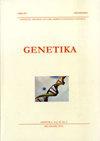HOTAIR/miR1轴在胃癌中作为潜在的化疗靶点
4区 农林科学
Q3 Agricultural and Biological Sciences
引用次数: 0
摘要
胃癌是世界上最常见的癌症之一。延迟诊断是患者死亡的最常见原因。长链非编码rna (Long noncoding rna, lncRNAs)是一类在癌症发病中起重要作用的非编码rna。不同肿瘤的研究表明HOTAIR在肿瘤发生过程中是一个重要的lncRNA。在胃癌中,HOTAIR在癌症发生和发展中的作用似乎是至关重要的。在本研究中,我们证实了HOTAIR在不同数据集的胃肿瘤和正常组织中的表达存在显著差异。下面我们分析HOTAIR在胃癌发生发展中的调控作用及其与mirna的相互作用。我们的分析确定HOTAIR的上调对于与胃癌进展相关的不同途径是必不可少的。进一步分析确定了许多mirna作为HOTAIR的潜在靶点。其中,我们发现miR-1是胃肿瘤中与HOTAIR负相关的显著miRNA。验证分析确定HOTAIR是顺铂作为常用化疗药物的靶点。最后,通过体外实验检查顺铂对HOTAIR及其潜在靶点miR-1表达的影响。顺铂对胃癌细胞系的治疗表明,处理细胞中HOTAIR的下调与miR-1的上调呈显著负相关。总之,综合的计算机分析和实验研究为HOTAIR/miR-1轴作为胃癌潜在的诊断和治疗策略的重要性提供了证据。本文章由计算机程序翻译,如有差异,请以英文原文为准。
HOTAIR/miR1 axis acts as a potential chemotherapy target in gastric cancer
Gastric cancer is one of the most common cancers in the world. Delayed diagnosis is the most common cause of death in patients. Long noncoding RNAs (lncRNAs) are a group of non-coding RNAs that are effective in the incidence of cancers. Studies in different cancers determined HOTAIR as an important lncRNA in tumorigenesis. In gastric cancer, the function of HOTAIR in the initiation and progression of cancer seems to be crucial. In this study, we confirmed the significant differential expression of HOTAIR between gastric tumors and normal tissues in different datasets. In the following, the regulatory function of HOTAIR and its interaction with miRNAs in development of gastric cancer was analyzed. Our analysis determined that the upregulation of HOTAIR is essential to different pathways associated with the progression of gastric cancer. Further analysis determined numerous miRNAs as potential targets for HOTAIR. Among them, we demonstrated miR-1 as a significant miRNA with negative correlation with HOTAIR in gastric tumors. Validation analysis determined that HOTAIR is a target of cisplatin as a common chemotherapy drug. Eventually, the effect of cisplatin on the expression of HOTAIR and its potential target, miR-1, was checked by an in vitro study. Cisplatin treatment on the gastric cancer cell line showed that there is a significant negative correlation between the downregulation of HOTAIR and the upregulation of miR-1 in treated cells. In conclusion, comprehensive in silico analysis and experimental study provided evidence for the importance of the HOTAIR/miR-1 axis as potential diagnostic and treatment strategies for gastric cancer.
求助全文
通过发布文献求助,成功后即可免费获取论文全文。
去求助
来源期刊

Genetika-Belgrade
AGRONOMY-GENETICS & HEREDITY
CiteScore
1.80
自引率
0.00%
发文量
1
审稿时长
6-12 weeks
期刊介绍:
The GENETIKA is dedicated to genetic studies of all organisms including genetics of microorganisms, plant genetics, animal genetics, human genetics, molecular genetics, genomics, functional genomics, plant and animal breeding, population and evolutionary genetics, mutagenesis and genotoxicology and biotechnology.
 求助内容:
求助内容: 应助结果提醒方式:
应助结果提醒方式:


